10 Unknown Nigerian Tribes That Will Blow Your Mind
Introduction
Nigeria’s diversity is astonishing, and many communities thrive outside the media spotlight. In this guide, we spotlight Unknown Nigerian tribes with care and respect, focusing on where they live, how they speak, what they make, and how they celebrate life. Our aim is simple: help you discover living cultures—without stereotyping or sensational claims—and encourage curiosity that honors people’s dignity.
We use “unknown” only in a friendly, descriptive sense. It doesn’t mean “hidden” or “less important.” It simply means these groups don’t often make national headlines, aren’t widely covered in school textbooks, or are concentrated in specific regions. We also keep details accurate yet accessible, avoiding unverified rumors, and steering clear of sensitive political disputes. When names vary (for example, older exonyms versus names communities prefer today), we note that too.
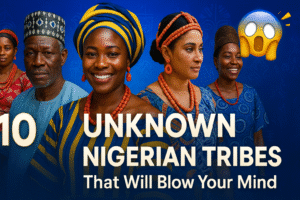
Why these Unknown Nigerian tribes will surprise you
Nigeria isn’t a single story. It’s a mosaic of communities spread across mountains, valleys, wetlands, and riverbanks, speaking languages that belong mainly to two super‑families: Niger–Congo and Afro‑Asiatic. Many communities maintain distinctive crafts—pottery, weaving, woodcarving, beadwork—and hold ceremonies tied to planting, harvest, age grades, or local leadership. What often makes these groups feel “unknown” is not size alone but visibility: limited national coverage, remote locations, or the use of names outsiders don’t immediately recognize.
In reading about these communities, it helps to remember a few things. First, identities are layered. A person can be local (village), ethnic (people), regional (state), and national (Nigerian) at once. Second, languages can be close cousins, even when names look unrelated. Finally, traditions are dynamic: people adopt new styles, keep old ones, and adapt to city life or schooling in creative ways. So, think of this guide as a respectful doorway—an invitation to learn more, not a final word.
What “unknown” means here
- Less media exposure: You’ll rarely see these communities in mainstream entertainment or big-city news cycles.
- Smaller or regionally concentrated populations: Many are centered in specific local government areas (LGAs).
- Name confusion: Older labels from neighboring languages sometimes overshadow the name people use for themselves.
Responsible storytelling
- No stereotypes: We avoid outdated or exoticizing descriptions.
- Names matter: Where older exonyms exist, we emphasize community-preferred names.
- Accuracy first: We focus on widely attested facts—location, language family, and everyday culture—presented clearly.
Selection criteria & scope
To build this list, we looked for (1) communities with distinctive identities; (2) clear regional anchors; (3) languages that reflect Nigeria’s deep linguistic diversity; (4) cultural markers like craft traditions, ceremonies, or leadership systems. We did not include well-known large groups that already receive broad coverage. And we keep the spotlight on aspects that can be shared confidently and respectfully.
What we left out (and why)
Some communities are famous nationwide; others are involved in sensitive contemporary disputes best handled by specialists or by the communities themselves. Our intention is discovery and appreciation, not controversy.
1: Koma (Adamawa)
Where they live: The Koma communities inhabit upland areas in the Alantika Mountains on the Nigeria–Cameroon border, within Adamawa State on the Nigerian side. Many settlements are hillside or foothill communities, with farming, gathering, and small-scale trade shaping daily life.
Language & identity: The Koma speak languages in the broader Adamawa cluster (within the Niger–Congo family). Naming varies across villages and between the Nigerian and Cameroonian sides, so you may encounter more than one form of the ethnonym in older materials. Local identity is tied to village networks, farmland, and age-grade responsibilities.
Culture & crafts: Farming cycles anchor the year—clearing, planting, weeding, harvest—alongside ceremonies and music. Household crafts include weaving, carving simple tools, and beadwork. Clothing styles range from contemporary wear in towns to traditional garments in remote hamlets, depending on age, occupation, and context.
Why they’re on this list: The Koma are sometimes presented with myth or exaggeration. In reality, they’re ordinary people with a mountain homeland and a strong sense of community. Learning about them broadens how we think about Unknown Nigerian tribes without sensationalism.
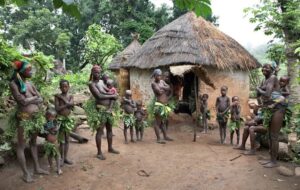
2: Kambari (Niger & Kebbi States)
Where they live: Kambari communities are found mainly in Niger State and adjoining parts of Kebbi State. Villages are often clustered around farmlands, with weekly markets binding communities together.
Language & neighbors: Kambari varieties belong to the Kainji group of Benue–Congo (within Niger–Congo). Many people are multilingual, using Kambari at home and regional lingua francas—such as Hausa—in trade or school. Neighboring communities exchange goods like grains, woven items, and livestock.
Culture & everyday life: Agriculture is central—millet, sorghum, and other staples—supported by seasonal labor groups. Attire ranges from everyday modern clothing to distinctive festival wear. Music, call-and-response singing, and drum ensembles animate weddings, harvest gatherings, and naming ceremonies.
Why they’re on this list: Despite their size and history, Kambari groups rarely appear in national media. Featuring them puts a human face on Unknown Nigerian tribes and highlights Nigeria’s Kainji-language heritage.
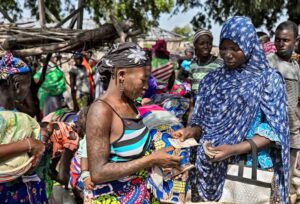
3: Bade (Yobe State)
Where they live: Bade communities are centered around Yobe State, notably near towns such as Gashua and the wider Hadejia–Nguru wetlands zone. Rivers and seasonal floodplains shape farming, fishing, and trade.
Language & connections: Bade is a Chadic language (Afro‑Asiatic family). Many speakers also use regional lingua francas for trade, education, and administration. Place names and clan histories knit together a sense of belonging across households and hamlets.
Culture & craft: Wetland life brings rice, wheat, vegetables, and fish into local diets. Artisans work leather, calabash, and wood; traders move between market towns with textiles, grain, and crafted goods. Celebrations feature music, drumming, and line dances that vary by occasion.
Why they’re on this list: The Bade illustrate how riverine landscapes nurture distinctive cultures that remain under the radar of mainstream coverage—exactly the kind of story you expect in Unknown Nigerian tribes features.
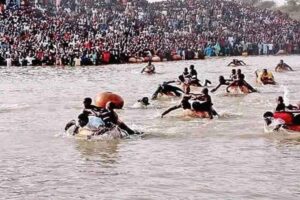
4: Eggon (Nasarawa State)
Where they live: The Eggon live primarily in Nasarawa State, including hill settlements and plains around agricultural belts. Many towns host lively markets where produce, pottery, and textiles change hands.
Language & arts: Eggon is part of the Plateau branch (Benue–Congo, within Niger–Congo). Community arts include storytelling, choral singing, and masked performances during festivals or communal rites. Carved masks, beadwork, and dyed cloth appear at celebratory events.
Community life: Farming communities organize work parties for planting and harvest. Apprentices learn from elders—how to farm, carve, sing, and mediate. Schooling and city work have added new layers, but family compounds and seasonal rhythms still anchor identity.
Why they’re on this list: Eggon traditions are vibrant yet not widely profiled in national media. Including them expands the lens of Unknown Nigerian tribes beyond the usual suspects.

5: Tangale (Gombe State)
Where they live: Tangale communities are found in Gombe State, with settlements around towns such as Billiri and Kaltungo and across adjoining farmlands and valleys. Weekly markets draw traders from surrounding areas.
Language & heritage: Tangale belongs to the West Chadic branch (Afro‑Asiatic). Many households are bilingual or trilingual, using Tangale at home while conducting trade or schooling in a regional lingua franca. Folk narratives about origins and migrations are shared across generations.
Culture & performance: Dance ensembles, drumming, and call-and-response choruses mark festivals, initiations, and weddings. Artisans craft pottery and metalwork; weavers produce utilitarian bags and wraps. Farming—grains, legumes, and vegetables—remains central to everyday life.
Why they’re on this list: The Tangale show how Chadic-speaking communities contribute to Nigeria’s cultural richness, even if they seldom headline national culture pages about Unknown Nigerian tribes.
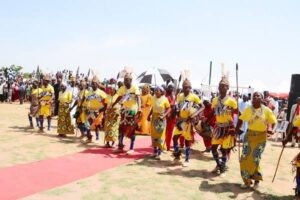
6: Kuteb (Taraba State)
Where they live: Kuteb communities are concentrated in Taraba State, particularly around the Takum–Ussa axis. Farmland mosaics—grains, tubers, vegetables—dominate the landscape, with footpaths linking homesteads, streams, and markets.
Language & kinship: Kuteb belongs to the Jukunoid group (Benue–Congo). Extended families share land, tools, and seasonal labor. Naming practices, praise songs, and age-grade responsibilities strengthen bonds across households.
Craft & ceremony: Kuteb artisans work wood, calabash, leather, and beads. Ceremonies feature drumming, flutes, and antiphonal singing. Market days bring community news—engagements, births, and harvests—alongside trade.
Why they’re on this list: Kuteb culture is distinctive yet underrepresented in mainstream profiles, fitting the spirit of Unknown Nigerian tribes that deserve wider appreciation.
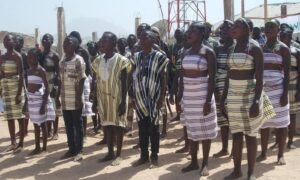
7: Mumuye (Taraba & Adamawa States)
Where they live: Mumuye communities are found mainly in Taraba State (including areas like Zing and Yorro) and parts of Adamawa. Their settlements range from hillside hamlets to small towns linked by trade routes and footpaths.
Language & identity: Mumuye languages fall within the Adamawa group (Niger–Congo). People often speak multiple languages, balancing home speech with regional lingua francas used in markets and schools. Clan histories, praise poetry, and proverbs anchor local identity.
Art & recognition: Mumuye wood sculpture is widely respected for its striking forms—elongated figures, stylized features, and balanced proportions—used in ritual contexts historically and celebrated today as an art tradition. Carvers learn by careful apprenticeship.
Why they’re on this list: Mumuye demonstrate how world‑class artistry can flourish in communities that remain little-known outside their regions—another strong example within Unknown Nigerian tribes conversations.

8: Goemai (Plateau State)
Where they live: The Goemai live primarily around Shendam in Plateau State, with villages stretching along roads, rivers, and farmland belts. Markets bustle with grain, vegetables, livestock, mats, and pottery.
Names & language: Community members prefer “Goemai,” though you may encounter older exonyms in archives. Goemai is a West Chadic language (Afro‑Asiatic). Many people use both Goemai and regional lingua francas daily, shifting smoothly between home and market speech.
Culture & craft: Pottery production is notable, as are woven mats and baskets. Storytelling, drumming, and choral songs color life events—naming ceremonies, initiations, marriages, and harvest celebrations.
Why they’re on this list: Goemai communities are culturally vibrant yet rarely discussed nationally—exactly the profile we aim to highlight when exploring Unknown Nigerian tribes.

9: Ron (Plateau State)
Where they live: Ron communities (you may also see “Rung” associated in some references) are centered around the Bokkos area of Plateau State. Farming—grains, vegetables, and small livestock—shapes daily schedules and festival calendars.
Language & ties: Ron is a Chadic language. Many people switch among Ron, a regional lingua franca, and English in school or official settings. Kin groups maintain networks across villages, coordinating farm work and ceremonies.
Culture & social rhythm: Household courtyards serve as hubs for food preparation, craftwork, and storytelling. Markets are weekly pulses where people trade produce, woven goods, and tools. Music and praise chants mark milestones—harvests, initiations, and weddings.
Why they’re on this list: Ron communities are a clear reminder that cultural depth isn’t limited to high-profile groups; Nigeria’s heartland is dotted with dynamic societies that simply don’t receive widespread coverage.

10: Bachama (Adamawa State)
Where they live: The Bachama (who also use the self-name “Bwatiye”) are based around Numan and adjoining settlements along the Benue River in Adamawa State. Riverbanks and floodplains shape farming, fishing, and local transport.
Language & leadership: Bachama is an Adamawa language (Niger–Congo). A recognized leadership institution—the Hama Bachama—serves as a cultural landmark and a focal point for public ceremonies. People balance hometown obligations with schooling and work in larger cities.
Music, ceremony & craft: Drumming ensembles, praise singing, and carefully choreographed dances animate festivals and life-cycle events. Artisans craft canoes, fish traps, and household tools; weavers and beadworkers add decorative detail for special occasions.
Why they’re on this list: The Bachama show how riverine landscapes nurture distinct cultural styles—music, craft, and leadership—within Nigeria’s diverse center-north.
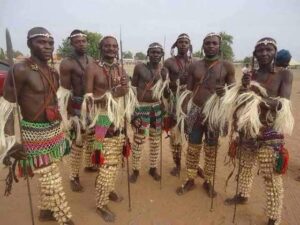
How to learn more—without intruding
- Start with museums and libraries: Look for exhibitions or books on Nigerian languages and arts.
- Seek community voices: When possible, learn from local cultural groups, teachers, and artisans.
- Be a respectful visitor: If you travel, ask before photographing, dress modestly, and follow local guidance.
- Buy crafts responsibly: Support artisans directly; fair payment keeps traditions alive.
- Remember complexity: Traditions evolve. People mix old and new in creative ways.
FAQs
1) Are these groups officially recognized?
Yes. These are living communities with languages and local institutions. “Unknown” only reflects visibility in mainstream coverage, not legitimacy or value.
2) Do these communities still practice their traditions today?
Yes, but traditions aren’t frozen. People adapt—combining schooling, city work, religion, and modern fashion with older arts, music, and ceremonies.
3) Can I visit any of these communities?
In principle, yes—if you do so respectfully and safely. Travel conditions vary by region and season. Always seek local advice, ask permission before photos, and consider community-led tours where available.
4) Why do names differ between sources?
Older exonyms, colonial spellings, or neighboring-language labels may persist. Many communities prefer endonyms (self-names) today. It’s courteous to ask and use the name people use for themselves.
5) Are these languages related to the big Nigerian languages I’ve heard of?
Sometimes. Many listed languages belong to Niger–Congo or Afro‑Asiatic families. They may be distant cousins to other languages you know, but each has its own sound system, grammar, and stories.
6) How did you choose just ten?
The goal was regional spread, linguistic diversity, and distinctive cultural markers—while staying focused on groups that get less mainstream coverage. There are many more communities worthy of exploration.
7) What’s the most respectful way to learn?
Listen first. Support local cultural initiatives, buy crafts fairly, and credit people and places accurately when you share what you’ve learned.
8) Are any of these communities the “oldest” in Nigeria?
History in Nigeria is deep and layered, and many groups trace long lineages. Rather than declare “oldest,” it’s better to value each community’s own origin stories and archaeological or linguistic evidence where available.
Conclusion
Nigeria’s cultural map is full of brilliance—mountain villages, river towns, and market hubs where languages, music, and crafts thrive. By getting to know communities like Koma, Kambari, Bade, Eggon, Tangale, Kuteb, Mumuye, Goemai, Ron, and Bachama, you step beyond headlines into everyday life—farm cycles, family stories, and ceremonies that renew social bonds. Stay curious, stay respectful, and keep learning. That’s how living traditions remain strong for generations.
Read also The Bakor Tribe Nigeria: Astonishing Guardians of Nigeria’s Ancient Stones


